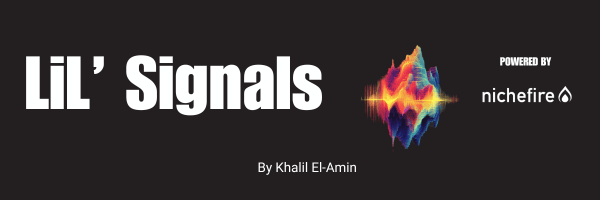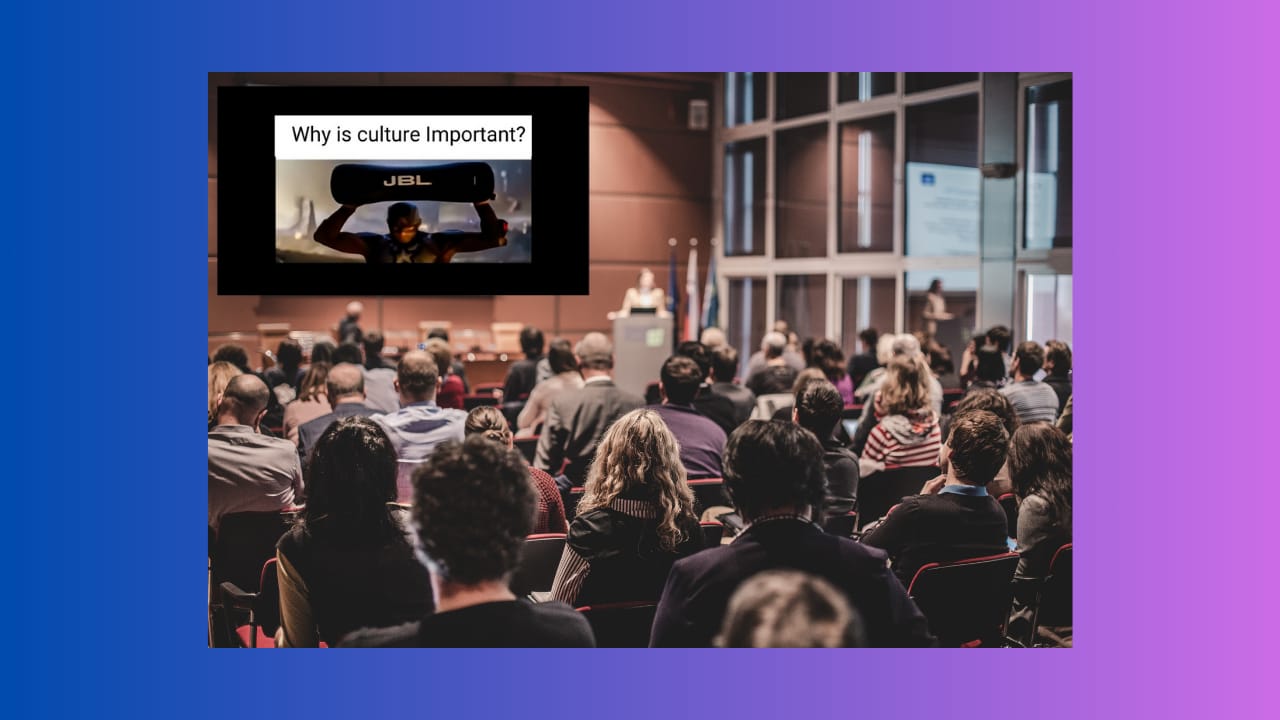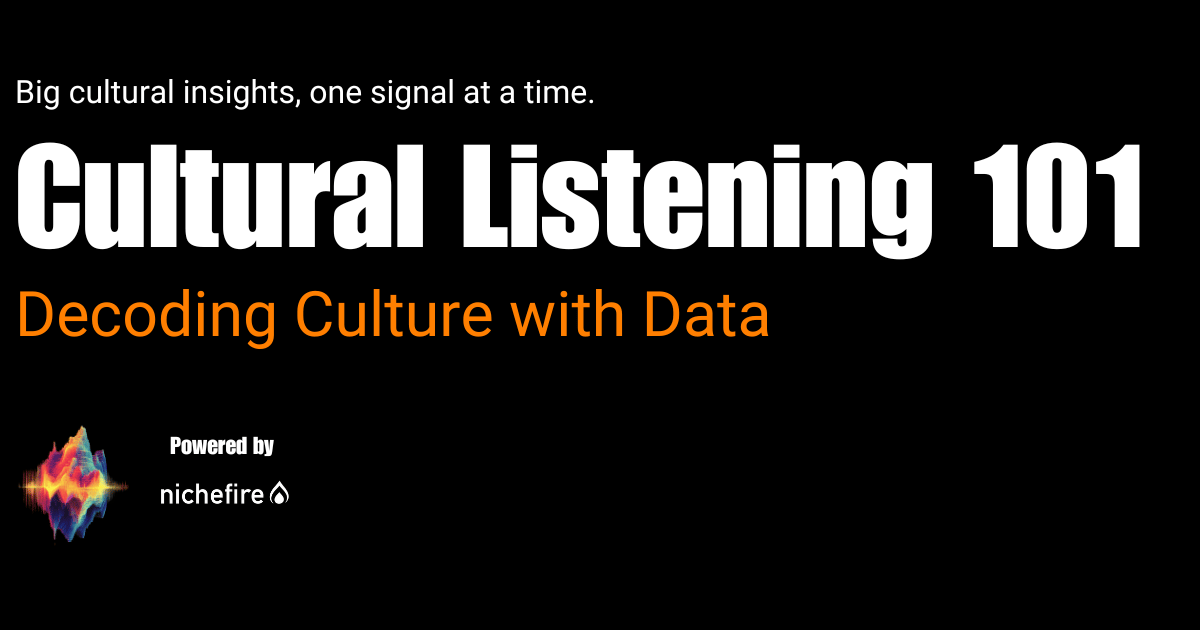- Lil' Signals
- Posts
- Lil' Signals: Culture is the Key to Understanding
Lil' Signals: Culture is the Key to Understanding
How Cultural Awareness Unlocks Deeper Connections and Better Conversations

👋🏽 Hey There
Lil’ Signals is your go-to newsletter for decoding the cultural currents shaping our world.
Powered by Nichefire’s cutting-edge technology, we break down trends, tell compelling stories, and share actionable insights on how to tap into the power of cultural listening.
Stay ahead of the curve—one signal at a time.
In this edition, we’re exploring the power of cultural understanding and how it influences human connection, business strategy, and storytelling.
From decoding workplace culture to the intersection of music and identity, we explore how brands and individuals can harness cultural insights to drive meaningful engagement.
Plus, we’ll break down how cultural listening transforms research into action, ensuring brands stay ahead of the curve by understanding not just what’s trending but why it matters.
Let’s dive in!! 🚀
Table of Contents

StoryTime
The Culture Code: How Understanding Culture Unlocks Human Connection

Culture is the silent architect of our beliefs, values, and behaviors.
It influences how we communicate, make decisions, and find common ground, even when we come from vastly different backgrounds.
For me, culture has been more than a concept—it’s been a survival skill, a bridge, and sometimes, a puzzle.
Growing up in Cincinnati, Ohio, my neighborhood was a mix of Black, Jewish, Christian, and Muslim communities.
This constant exposure to different traditions meant I was always navigating multiple cultural worlds.
At a friend’s house, Christmas and Easter were major events, while at home, Ramadan and Eid took center stage.
The conversations, food, and social norms varied, but at their core, they reflected shared values of family and tradition.
These early experiences taught me that culture isn’t about better or worse—it’s about meaning.
Culture as a Survival Skill
As I got older, recognizing cultural nuances became essential, especially when I entered the world of sports.
Playing football at the University of Cincinnati, I was part of a team with players from all over the country—some from big cities, others from rural towns.
Our backgrounds shaped our perspectives: one teammate from Louisiana introduced me to Cajun cooking, while another from the Midwest credited farming with his discipline.
Even the way we celebrated wins or handled losses carried cultural weight.
Understanding these differences made us stronger as a team.
The Culture Shift: From Locker Room to Boardroom
After college, transitioning to the corporate world felt like entering another cultural arena.
If you’ve ever moved from one industry to another or from school to work, you know what I mean.
Every workplace has its own culture—its unspoken rules, communication styles, and expectations.
At first, corporate culture felt foreign.
Football had taught me direct, high-energy communication, but in business, meetings had unwritten etiquette, emails required formality, and networking events had their own choreography.
Yet, the parallels between business and sports became clear: just as a football team has coaches, captains, and rookies, companies have leadership structures.
The same way teams have rituals before a game, businesses have quarterly meetings and company traditions.
Adapting to corporate culture wasn’t about losing my identity—it was about knowing when to adjust and when to bring my unique perspective to the table.
The Power of Cultural Understanding
One of the biggest lessons I’ve learned is that culture isn’t always something you see—it’s something you feel.
It’s why a joke lands in one setting but falls flat in another, why some people communicate directly while others rely on subtlety.
I’ve had conversations with people who, at first glance, seemed to have nothing in common with me.
But as soon as we talked about family traditions, childhood memories, or music, we found shared ground.
That’s the magic of culture—it creates unexpected bridges between people.
Take music, for example.
Have you ever played a song and watched someone’s face light up with nostalgia?
I’ve seen hip-hop fans connect with country music lovers over shared emotions in lyrics.
I’ve watched people from different generations bond over a song that was sampled from an old classic.
Like culture, music is deeply personal yet universally understood.
Culture Evolves—So Should We
Culture isn’t static. It shifts with time, shaped by new ideas, technology, and exposure to different perspectives.
What’s considered normal today might evolve into something completely different in a decade.
Look at language—slang changes with every generation.
What was cool to say in the ’90s sounds outdated now.
Entertainment consumption has also evolved; streaming platforms have made K-pop, anime, and international films mainstream in places where they were once niche.
Just as culture evolves, our understanding of it should, too.
For businesses, this is crucial.
Brands that thrive aren’t just selling products; they’re tapping into culture.
They understand the shifting tides of consumer behavior, generational values, and emerging trends before they hit the mainstream.
Companies that ignore cultural signals risk falling behind, misreading their audience, or missing opportunities.
The Key to Understanding
At its core, understanding culture isn’t about memorizing facts—it’s about empathy.
It’s about being open to perspectives outside your own, recognizing the experiences that shape people’s behaviors, and finding ways to connect on a human level.
Culture is what helps us make sense of each other.
Without it, we’re just making assumptions, missing out on the depth that makes human interaction so rich.
Whether you’re stepping into a new job, traveling to another country, or trying to understand someone different from you—start with culture.
It’s the key to deeper connections, better conversations, and a more meaningful world.
I’d love to hear your thoughts. What cultural experiences have shaped your perspective?
Let’s keep the conversation going.
Let’s explore the power of culture, one signal at a time.

Cultural Listening 101

Closing the Loop Between Research and Creativity
Cultural listening isn’t just about gathering insights—it’s about turning data into action. Too often, research generates reports that never make it to the teams responsible for storytelling, campaign development, or product innovation. The real power of cultural listening is its ability to bridge the gap between research and creativity, ensuring insights don’t just inform strategy but fuel content and marketing execution.
On a recent call, a prospect shared their challenge: They had access to a wealth of research—social listening data, trend reports, audience insights—but struggled to translate it into creative action. They needed a way to complete the full circle, ensuring data didn’t just live in reports but actively shaped campaigns, content, and product decisions.
This is exactly where cultural listening delivers value. It transforms research from a passive process into an active loop, connecting insights directly to creative strategy. Here’s how forward-thinking brands are using cultural listening to turn insights into impact.
1. Identifying Cultural Signals Early
Cultural listening allows brands to spot emerging trends before they go mainstream. Instead of tracking broad conversations, brands can pinpoint the specific ways audiences are engaging with a topic.
For example, rather than simply tracking mentions of sustainability, cultural listening uncovers how consumers discuss it—whether the focus is on ethical sourcing, food waste, or plant-based alternatives. This level of nuance allows for more targeted, culturally relevant storytelling.
2. Contextualizing Data for Creatives
Raw data doesn’t inspire action—stories do. That’s why cultural listening isn’t just about identifying trends but uncovering the human stories behind them.
Take sneaker culture, for instance. A rise in searches for retro basketball shoes isn’t just about fashion—it’s about nostalgia, Gen Z’s influence on style, and the blending of sports and streetwear aesthetics.
For creative teams, this isn’t just data—it’s a narrative. It informs campaign messaging, creative direction, and even influencer partnerships. Instead of making assumptions, teams can develop stories that align with how people actually feel and engage with a trend.
3. Fueling Content, Campaigns, and Brand Messaging
Once cultural insights are distilled into meaningful narratives, brands need to activate them. This is where cultural listening becomes an essential tool for:
Refining brand voice – ensuring messaging aligns with audience sentiment.
Identifying the right platforms – knowing whether a conversation is thriving on TikTok, Reddit, or LinkedIn.
Connecting with the right creators – partnering with voices that already resonate with a trend.
By integrating cultural insights at the start of the creative process, brands avoid reactive marketing and instead build authentic, forward-thinking campaigns.
4. Measuring Impact and Refining Strategy
Once a campaign launches, cultural listening closes the loop by tracking real-time audience engagement:
How are people responding?
Did the messaging resonate, or does it need adjusting?
Are consumers using the same language the brand introduced?
This allows brands to continuously refine their approach instead of relying on outdated assumptions. Cultural listening isn’t just about tracking what’s trending—it’s about understanding why and using that knowledge to stay ahead.
Why This Matters for Brands Today
Consumers expect brands to be culturally aware and actively engaged in the conversations that matter to them. Cultural listening makes this possible by:
✅ Keeping brands relevant – ensuring messaging reflects real-time consumer sentiment.
✅ Inspiring creativity – giving content teams data-driven insights to build authentic campaigns.
✅ Driving storytelling – shaping narratives based on cultural realities, not assumptions.
Closing the Gap Between Research and Creation
The most successful brands don’t let research exist in a silo. They use cultural listening to turn insights into strategy, strategy into storytelling, and storytelling into action.
That’s the full-circle approach—listening, analyzing, creating, and evolving. Brands that embrace this mindset don’t just follow culture—they help shape it.
— Khalil
Want to see it in action?
Reach out for a walkthrough and start making cultural listening work for you.
See you next week for another installment of Cultural Listening 101.
Thank you for subscribing to Lil’ Signals.
If you enjoyed this post or know someone who may find it useful, please share it with them and encourage them to subscribe: https://lilsignals.beehiiv.com/p/lil-signals-decoding-culture-one-insight-at-a-time?draft=true

Content Engines
I want to see what You can create!
Got a cool AI-generated video?
Creative Experiment?
A bold Idea?
Share it with us!
Reply to this email with your best creations, and let’s see who’s leading the AI content revolution. 📤✨

Top Cultural Trends
Stay Ahead with Nichefire
In this new section, we’re diving into Nichefire’s unique tools to explore the top cultural trends shaping our world.
This week, we break down key insights from the Movements Matrix, spotlighting high-growth and emerging trends across 47 cultural categories
Spot Emerging Trends: Discover niche opportunities before they hit the mainstream.
Actionable Insights: Leverage cultural data to make faster, smarter decisions.
Comprehensive View: Analyze trends across 47 pre-trained cultural categories.
Lil’ Surfing 🌊
Just interesting articles I find on “The Internets” 😜

💬 Your journey into the world of cultural insights starts here!
Thank you for being part of the Lil’ Signals community. Together, we’ll decode the world, one signal at a time.
Reply